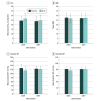Cardio-Oncology Rehabilitation for Cancer Survivors With High Cardiovascular Risk: A Randomized Clinical Trial
- PMID: 37819656
- PMCID: PMC10568446
- DOI: 10.1001/jamacardio.2023.3558
Cardio-Oncology Rehabilitation for Cancer Survivors With High Cardiovascular Risk: A Randomized Clinical Trial
Abstract
Importance: Cardiovascular disease is a leading cause of morbidity in cancer survivors, which makes strategies aimed at mitigating cardiovascular risk a subject of major contemporary importance.
Objective: To assess whether a center-based cardiac rehabilitation (CBCR) framework compared with usual care encompassing community-based exercise training (CBET) is superior for cardiorespiratory fitness improvement and cardiovascular risk factor control among cancer survivors with high cardiovascular risk.
Design, setting, and participants: This prospective, single-center, randomized clinical trial (CORE trial) included adult cancer survivors who had exposure to cardiotoxic cancer treatment and/or previous cardiovascular disease. Enrollment took place from March 1, 2021, to March 31, 2022. End points were assessed at baseline and after the 8-week intervention.
Interventions: Participants were randomly assigned in a 1:1 ratio to 8 weeks of CBCR or CBET. The combined aerobic and resistance exercise sessions were performed twice a week.
Main outcomes and measures: The powered primary efficacy measure was change in peak oxygen consumption (V̇o2) at 2 months. Secondary outcomes included handgrip maximal strength, functional performance, blood pressure (BP), body composition, body mass index (BMI; calculated as weight in kilograms divided by height in meters squared), lipid profile, plasma biomarker levels, physical activity (PA) levels, psychological distress, quality of life (QOL), and health literacy.
Results: A total of 75 participants completed the study (mean [SD] age, 53.6 [12.3] years; 58 [77.3%] female), with 38 in the CBCR group and 37 in the CBET group. Participants in CBCR achieved a greater mean (SD) increase in peak V̇o2 than those in CBET (2.1 [2.8] mL/kg/min vs 0.8 [2.5] mL/kg/min), with a between-group mean difference of 1.3 mL/kg/min (95% CI, 0.1-2.6 mL/kg/min; P = .03). Compared with the CBET group, the CBCR group also attained a greater mean (SD) reduction in systolic BP (-12.3 [11.8] mm Hg vs -1.9 [12.9] mm Hg; P < .001), diastolic BP (-5.0 [5.7] mm Hg vs -0.5 [7.0] mm Hg; P = .003), and BMI (-1.2 [0.9] vs 0.2 [0.7]; P < .001) and greater mean (SD) improvements in PA levels (1035.2 [735.7] metabolic equivalents [METs]/min/wk vs 34.1 [424.4] METs/min/wk; P < .001), QOL (14.0 [10.0] points vs 0.4 [12.9] points; P < .001), and health literacy scores (2.7 [1.6] points vs 0.1 [1.4] points; P < .001). Exercise adherence was significantly higher in the CBCR group than in the CBET group (mean [SD] sessions completed, 90.3% [11.8%] vs 68.4% [22.1%]; P < .001).
Conclusion and relevance: The CORE trial showed that a cardio-oncology rehabilitation model among cancer survivors with high cardiovascular risk was associated with greater improvements in peak V̇o2 compared with usual care encompassing an exercise intervention in a community setting. The CBCR also showed superior results in exercise adherence, cardiovascular risk factor control, QOL, and health literacy.
Trial registration: ClinicalTrials.gov Identifier: NCT05132998.
Conflict of interest statement
Figures


Comment in
-
Cardio-Oncology Rehabilitation Programs-The Next Phase in Improving Care for Cancer Survivors.JAMA Cardiol. 2023 Dec 1;8(12):1128-1130. doi: 10.1001/jamacardio.2023.3568. JAMA Cardiol. 2023. PMID: 37819675 No abstract available.
References
-
- Lyon AR, López-Fernández T, Couch LS, et al. ; ESC Scientific Document Group . 2022 ESC guidelines on cardio-oncology developed in collaboration with the European Hematology Association (EHA), the European Society for Therapeutic Radiology and Oncology (ESTRO) and the International Cardio-Oncology Society (IC-OS). Eur Heart J. 2022;43(41):4229-4361. doi:10.1093/eurheartj/ehac244 - DOI - PubMed
-
- Strongman H, Gadd S, Matthews A, et al. . Medium and long-term risks of specific cardiovascular diseases in survivors of 20 adult cancers: a population-based cohort study using multiple linked UK electronic health records databases. Lancet. 2019;394(10203):1041-1054. doi:10.1016/S0140-6736(19)31674-5 - DOI - PMC - PubMed
-
- Lyon AR, Dent S, Stanway S, et al. . Baseline cardiovascular risk assessment in cancer patients scheduled to receive cardiotoxic cancer therapies: a position statement and new risk assessment tools from the Cardio-Oncology Study Group of the Heart Failure Association of the European Society of Cardiology in collaboration with the International Cardio-Oncology Society. Eur J Heart Fail. 2020;22(11):1945-1960. doi:10.1002/ejhf.1920 - DOI - PMC - PubMed
MeSH terms
Associated data
LinkOut - more resources
Full Text Sources
Medical

